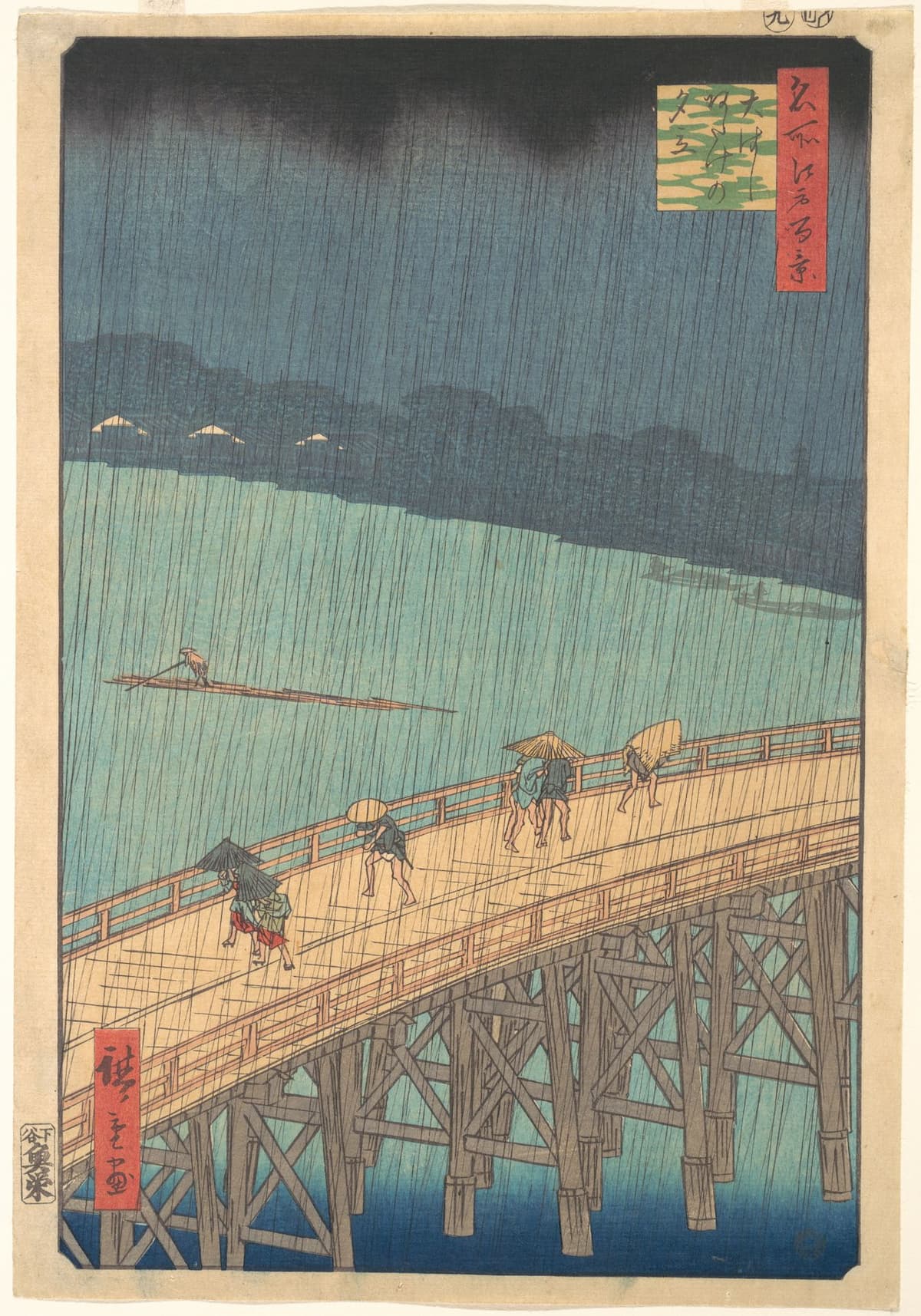Geoffrey Poole: Crossing Ohashi Bridge
The travellers on the bridge hunch down under their small straw coverings – the rain is pouring down, catching them on the exposed walkway.

Hiroshige: One Hundred Famous Views of Edo: Sudden Shower over Shin-Ōhashi bridge and Atake, 1857, first printing (New York: Metropolitan Museum of Art)
Part of Hiroshige’s series One Hundred Famous Views of Edo, which had been commissioned after the 1855 earthquake that leveled the city, the views showed many of the new or rebuilt buildings of the city.
In the picture, we see part of the Shin-Ōhashi (New Great) bridge over the Sumida River. It was built only in 1885 and was the last wooden bridge across the river in the Meiji era (1868–1912). It was replaced by a modern steel bridge in 1911, which was replaced again in 1974. The curve of the bridge is Hiroshige’s artistic addition, as the bridge itself was straight across.
On the bridge are two women and four bare-legged men, using a hat, umbrellas, or a straw cape (mino) to shield themselves from the shower. In the river is a log raft being moved by a man in a mino towards the Fukagawa lumber yards upstream. Heavier and lighter lines in two directions give us the rainfall. On the far bank, lighted regions show three houses in the area called Atake. In later prints, these lighter areas do not appear this clearly, and the men in the boats on the right side vanish completely.
So many of these ukiyo-e prints were influential on European painters, and this is one of the prints that Vincent van Gogh studied. He collected and looked at his Japanese prints to get a feeling for how they created cropped compositions, how blocks of colour were used, and the use of diagonals in the image.
We can see his distinctive use of yellow on the bridge and his use of green shading on the bridge supports elements that are not in the Hiroshige original. The water, too, has been detailed in green, grey-blue, and white and has a more menacing appearance than in the original print. Atake has been made brighter.

Van Gogh: Bridge in the Rain (after Hiroshige), 1887 (Van Gogh Museum, Amsterdam)
And now to the music. British composer Geoffrey Poole chose the Hiroshige work as the inspiration for his 1995 composition Crossing Ohasi Bridge. One of the elements of current news that he included in his vision was the movements of people in the early 1990s from places such as Eastern Europe, North Africa, Iraq, and Tibet across dangerous territory and via dangerous modes of transportation toward an uncertain future in another country.
Like the arc of Hiroshige’s bridge, Poole’s work also has an arc. His early drafts worked on 17 musical ideas that explored changing sonorities.
Mist (dawn)
Shower
Processional (chorus of violas)
Sho (ceremonial Japanese harmonium)
Chase
Shafts of Light
Bees
Swirling Wind
Deep Silver Whorl (stasis)
Squall
Braids and Tendrils
Con- /Di-verging Explosions
Peripetie (violin solo)
Downward Steps
Undeclared Personages (cello melody)
Purple Whorl
Mist (dusk)
We hear the rain first – just a plock here and there and then the deluge of slashing water. Japanese elements come in with the cellos, and then Poole starts to add in things that aren’t in the image: shafts of light, bees, swirls in the water, and steps. All of these add to the imagery in the music.
Geoffrey Poole: Crossing Ohashi Bridge (Goldberg Ensemble; Malcolm Layfield, cond.)
Hiroshige gives us a moment in time: the travellers on the bridge have a hope of making it to land before they’re completely drenched, but since Hiroshige shows us a bridge with no beginning and no end, the traveller’s hopes may be in vain.
For more of the best in classical music, sign up for our E-Newsletter
